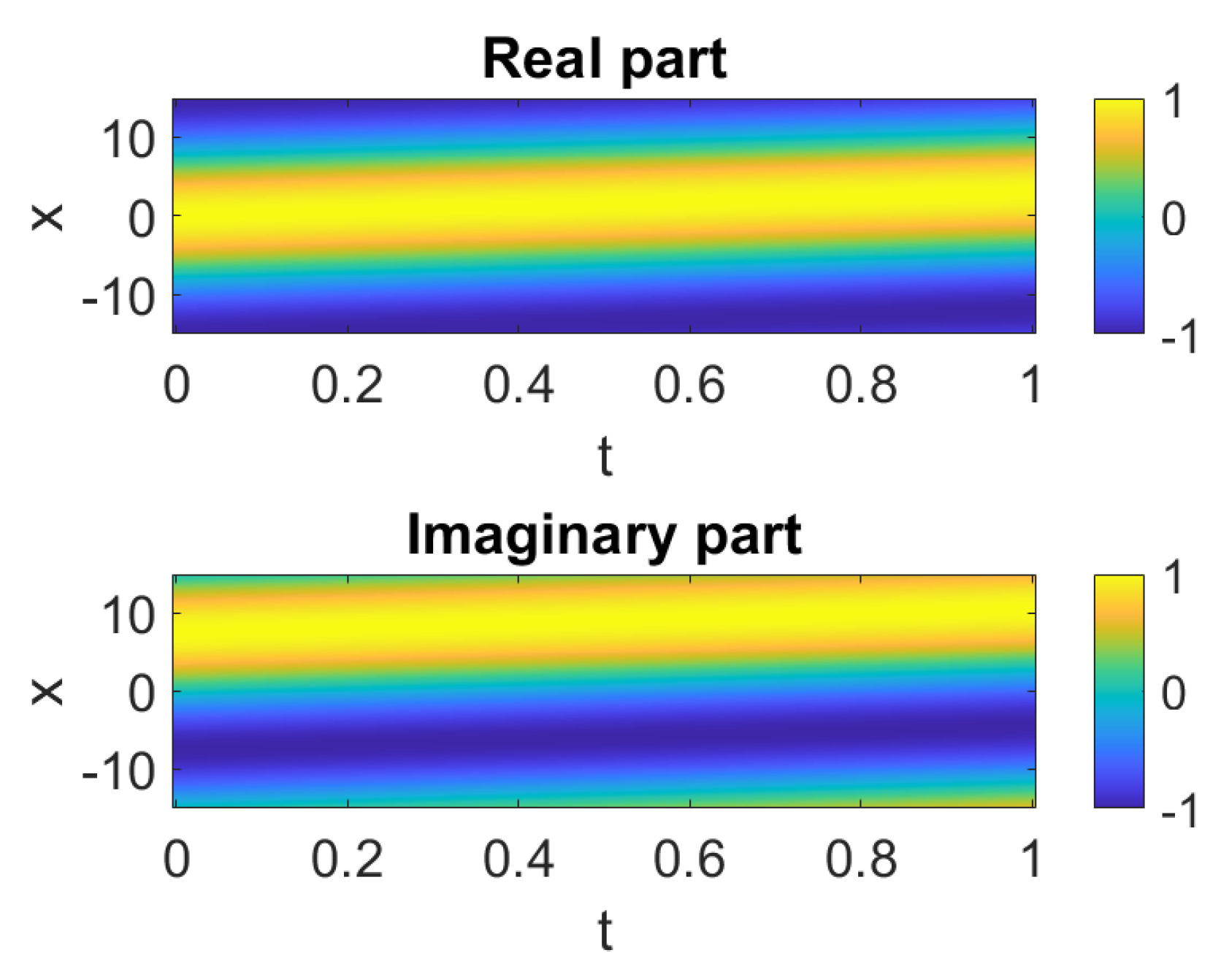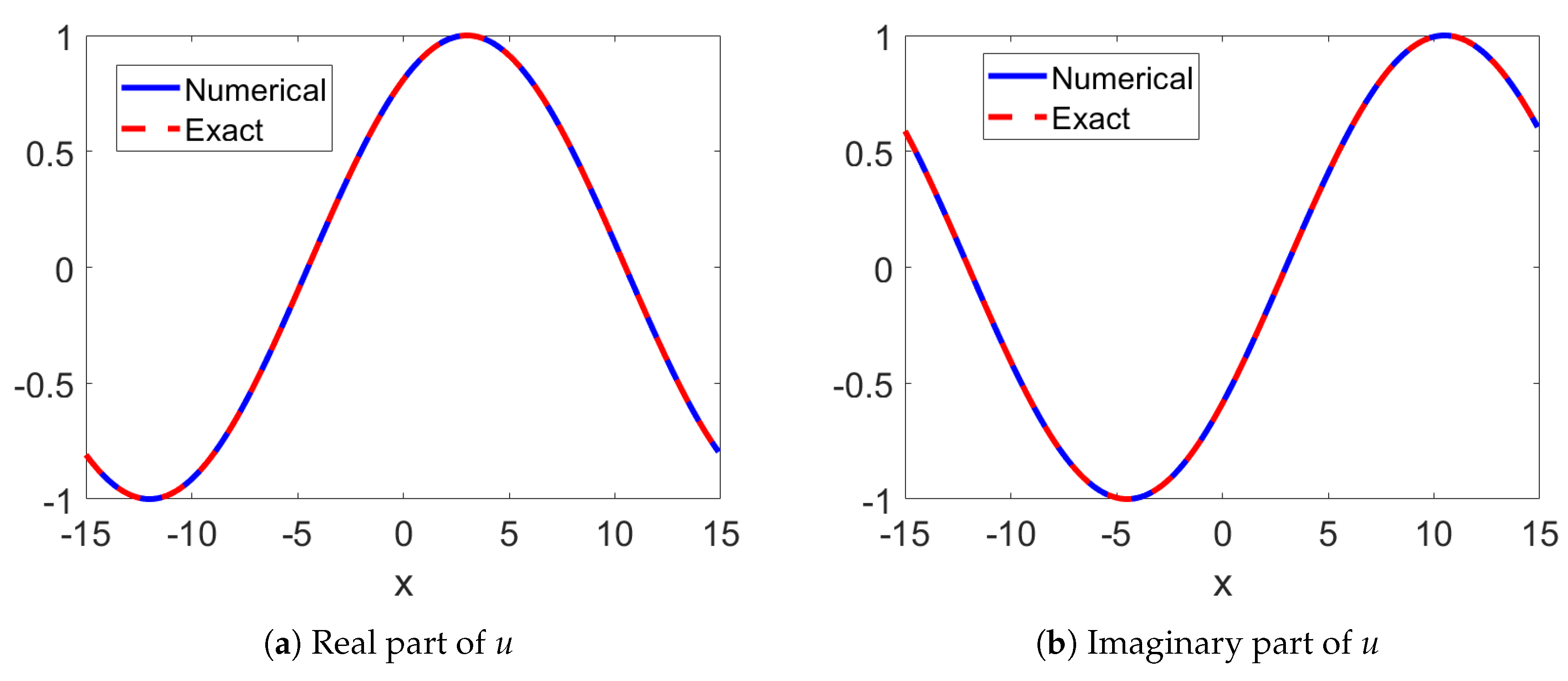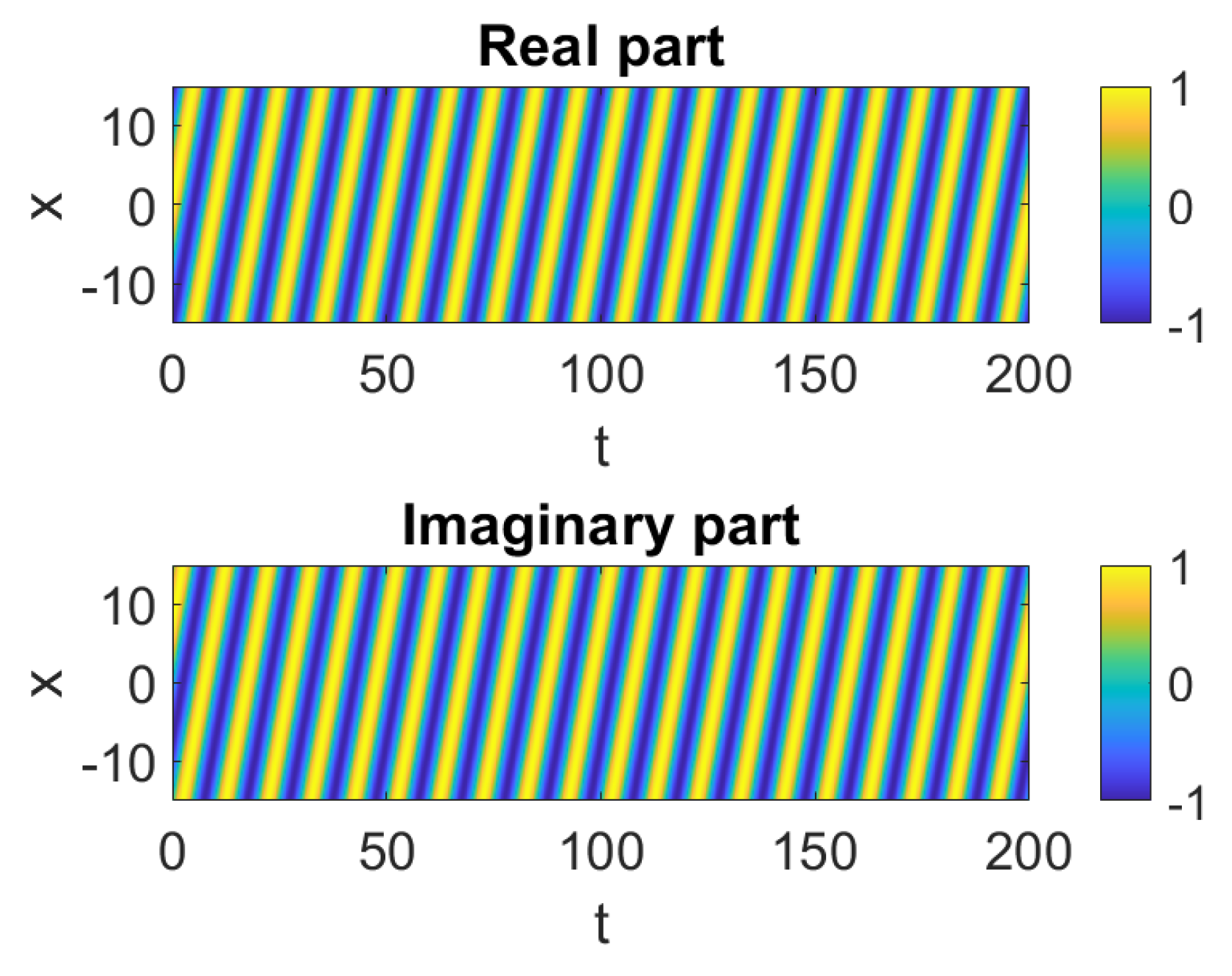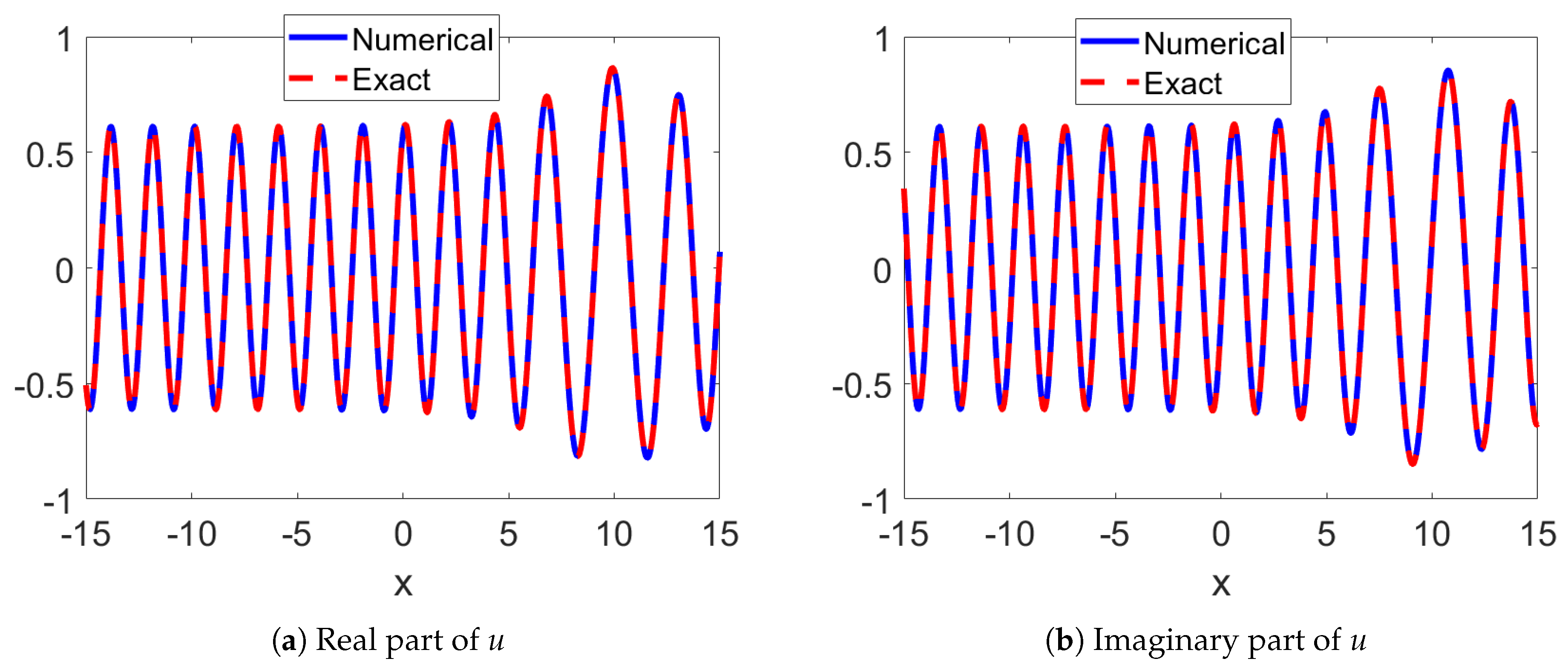1. Introduction
In this paper, we consider the initial-boundary value problem for the following nonlinear Schrödinger equation with an anti-cubic nonlinearity:
for
,
, where
L and
T are given positive constants. The solution
is a complex-valued function, and
is a given real-valued function. In Equation (
1),
denotes the modulus of the function
u. The three nonlinear terms, i.e.,
,
, and
, correspond to the anti-cubic, cubic, and quintic terms, respectively. Equation (
1) is considered with the initial condition
and periodic boundary conditions.
This problem possesses two key conservation laws: mass and energy conservations, given by
and
respectively. Note that in Equation (
3), the energy is exactly conserved (i.e.,
) in the classical sense when
. More generally, if the modulus of
u remains constant over time, as in one of the numerical examples in
Section 5, the energy is also conserved even when
. In other cases with general
f, the energy may vary due to the integral term on the right-hand side of (
3). Nevertheless, we continue to refer to Equation (
3) as the energy conservation law, following the terminology commonly used in the literature. Therefore, in order to design an effective numerical scheme, one must not only ensure high accuracy in approximating the solution, but also preserve the conservation properties in the discrete sense.
The nonlinear Schrödinger equation with an anti-cubic term was first introduced by Fedele et al. [
1] in 2003. Since then, it has attracted significant attention from researchers worldwide. The anti-cubic nonlinearity has been shown to play a critical role in stabilizing soliton solutions, even in the presence of perturbations, allowing solitons to persist over longer times and across larger spatial domains [
2].
In the literature, a wide range of analytical methods have been developed to construct exact soliton solutions, including the Jacobi elliptic function method [
3], extended trial function method [
4,
5], csch method, extended tanh–coth method, modified simple equation method [
6], and mapping method [
7]. Ramzan et al. [
8] further explored analytical approaches such as the
-function method, modified Kudryashov method, and generalized tanh method. However, these analytical techniques often rely on symbolic computation and assume ansatz forms for the solutions, which limits their applicability to general initial conditions and leads to considerable algebraic complexity.
To address these limitations, we propose a high-order numerical method that achieves provable convergence and preserves conservation properties. To the best of our knowledge, few studies have focused on numerical methods for Schrödinger equations with anti-cubic nonlinearity, despite the fact that this model generalizes the well-studied cubic–quintic case. Among all the work, there are some articles particularly focusing on developing high-order numerical methods with conservation properties. For example, Hu and Hu [
9] introduced a compact finite difference method for the cubic–quintic Schrödinger equation. They proved the fourth-order spatial convergence and conservation of mass and energy. Yang [
10] proposed a local discontinuous Galerkin method with Crank–Nicholson time discretization and established conservation properties in both semi-discrete and fully discrete settings. More recently, Le, Huynh and Nguyen [
11] studied a Crank–Nicholson finite difference scheme for the (2 + 1)D cubic–quintic Schrödinger equation with cubic damping and proved existence and uniqueness of the numerical solution.
Building on these developments, we propose a fourth-order compact finite difference method to approximate the spatial derivative in Equation (
1) in order to achieve high-order accuracy in
x. A central feature of our method is its provable mass and energy conservation. That is, the invariants given in (
2) and (
3) are preserved in the discrete formulation, which is of fundamental importance in many physical applications. In the broader context of conservative numerical methods for nonlinear Schrödinger-type equations, various approaches have been developed, including finite difference methods [
9,
12,
13,
14,
15,
16,
17], spectral methods [
18,
19,
20], (local and direct) discontinuous Galerkin methods [
21,
22,
23,
24,
25], and wavelet-based methods [
26,
27]. Most of these schemes use standard spatial discretization techniques combined with Crank–Nicholson or other time-stepping methods. However, a direct application of the standard Crank–Nicholson method to Equation (
1) does not lead to a numerical method with provable energy conservation property due to the nonlinear terms in (
1). To overcome this obstacle, we carefully design a discretization that ensures both mass and energy conservation can be rigorously proved. Furthermore, under suitable assumptions on the exact solution, we establish bounds for the numerical solution in both the 2-norm and
∞-norm, and derive error estimates confirming fourth-order accuracy in space and second-order accuracy in time, which together guarantee stable and accurate numerical solutions.
The remainder of this paper is organized as follows. In
Section 2, we introduce the notation used throughout the paper, state the assumptions needed for the theoretical analysis, and present our proposed numerical method for the Schrödinger equation with an anti-cubic term.
Section 3 provides the main results on the conservation properties of the method, along with their mathematical proofs. In
Section 4, we establish bounds for the numerical solution in the 2-norm and the
∞-norm, and derive error estimates in these norms.
Section 5 presents numerical examples to verify the fourth-order spatial convergence of the method and to demonstrate the conservation of discrete mass and energy. Finally,
Section 6 concludes the paper with a summary and discussion.
2. Compact Finite Difference Method for the Problem
In this section, we introduce our proposed fourth-order compact finite difference method for Equation (
1) under the given initial and boundary value conditions.
We begin by defining the mesh, grid points, and solution space. The spatial domain is divided into J uniform subintervals , where and the spatial mesh size is for . The temporal domain is partitioned into N subintervals such that , where is the time step size. Throughout the paper, we use and to represent the numerical and exact solutions at the grid point , respectively.
Next, we define the following discrete operators:
to represent the first-order forward difference in time and the second-order centered difference in space. We further define the operator
by
It is well known that the inverse operator of
acting on
, i.e.,
, yields a fourth-order approximation of the second spatial derivative.
Due to the periodic boundary condition of the problem, we define the solution space at each time step as
For any
, we define the grid inner product by
where
denotes the complex conjugate of
. The
p-norm and
∞-norm of
are defined as
for
.
We also assume the exact solution satisfies the following condition:
Here,
is the column vector representing the exact solution at time
, and
C is a generic positive constant. We assume this condition holds for all
. Additionally, we assume the existence of a positive constant
such that
The assumption in Equation (
8) ensures that the solution to Equation (
1) is well-defined.
Furthermore, to establish the error estimates in Theorems 3–5, we assume that the exact solution is sufficiently smooth, specifically , i.e., six times continuously differentiable in space and three times in time.
Our proposed Crank–Nicholson compact finite difference method is defined as follows:
for
and
. Here,
represents
. We rewrite the scheme above in vector form by defining
, and denoting the matrix form of the discrete operator
as
Additionally, we introduce the following notation:
,
, and
, to represent diagonal matrices, defined by
Similarly,
denotes a diagonal matrix defined analogously. Using this notation, Equation (
9) can be rewritten compactly as
Note that the matrix
M in the system above is symmetric positive definite. We denote its inverse by
H, which is also symmetric positive definite. With this, the system of equations can be reformulated as
for
. The initial condition is given by
.
4. Stability and Error Estimates
In this section, we analyze the stability and accuracy of the proposed scheme (
12). As established in Theorem 1, the boundedness of
for all
n implies the stability of the scheme in 2-norm. We further show that the numerical solution is also bounded in the
∞-norm, and we establish the convergence order of the scheme.
Throughout this section, we use C to denote a generic positive constant that is independent of the spatial mesh size h, the time step size , the number of spatial intervals J, and the number of time steps.
The following two lemmas will be used in proving the main theorems in this section:
Lemma 3. For any and any given constant , there exists a constant C, depending only on ϵ, such that Lemma 4. For any symmetric positive definite matrix H, there exist two positive constants and such that Among the two lemmas introduced above, Lemma 3 corresponds to the discrete Sobolev inequality (see [
29]). The proof of Lemma 4 can be found in [
14]. We now present a result on the positivity and boundedness of
:
Theorem 2. Suppose the real-valued function in (1) satisfies and for all x and t in the domain, where and are given constants. Additionally, assume that and that is bounded between two positive constants. Then, there exist constants with such thatfor any all and n with . Proof. From the discrete energy conservation law (14), we have
which leads to the following inequality:
The second inequality above follows from the mean value theorem and the assumed boundedness of
and
. Applying Lemma 4 to the left-hand side of (
17), we obtain:
This implies:
Next, we apply Lemma 3 with
, and use inequality (
19), yielding
which implies
for all
and
.
Moreover, inequality (
17) also implies:
From this, we derive:
Using the definition of the norm and the assumptions on
from the theorem statement, we conclude that the right-hand side of (
21) is independent of
h, and maybe be denoted by a generic constant
. Hence, we obtain
, which completes the proof. □
We now turn to the convergence analysis of the proposed scheme. The first step is to estimate the truncation error
, defined by:
where
is the exact solution vector at
. The following theorem establishes the order of this truncation error.
Theorem 3. Let . Then the truncation error satisfies .
Proof. Applying the properties of the fourth-order compact finite difference operator to Equation (
22), we derive
We note the following approximations:
,
,
, and
.
We also estimate
and
. For the first term, we derive
and substitute these estimates to obtain
Similarly for the second term, we show that
Finally, substituting these estimates into Equation (
23), we obtain
which concludes the proof. □
Using Theorem 3, we now estimate the error in the 2-norm:
Theorem 4. Under assumptions (7) and (8), and the conditions of Theorems 2 and 3, the error satisfiesfor sufficiently small τ, and for all . Proof. Subtracting Equation (
12) from the truncation error Equation (
22) yields the error equation:
where each component of the vectors
,
and
are defined as:
for
.
Next, we estimate the upper bound for each of
,
and
. For
, we rewrite it as
From Theorem 2 and the assumption (
7), we get
and estimate
as
, which leads to
To estimate
, we rewrite
as
Applying the following identities:
we obtain
Further application of the assumption (
7) and Theorem 2, we obtain the following inequality
, which leads to
For
, we rewrite it as
According to the assumptions (
7) and (
8), along with the conclusion of Theorem 2, we derive that
and
. Thus, inequality (
27) leads to
, which implies
Taking the grid inner product of the error Equation (
24) with
and extracting the imaginary part gives:
Label each term on the right-hand side of Equation (
29) as
for
. Then, we estimate the upper bound of each term. For
, we derive that
The term
can be simplified as
To estimate the upper bound of
, we apply the Cauchy–Schwartz inequality and inequality (
25). Specifically,
Similarly, inequalities (
26) and (
28) lead to
and
Utilizing the property of the real-valued function
, we also show that
Therefore, Equation (
29) leads to
Applying Theorem 3 to estimate
and use the fact that
, the inequality above is equivalent to the following inequality:
which can be rewritten as
assuming that
is sufficiently small, for instance,
, so that
. Let
and
, then we can show that
Here we have used the fact that
due to the given initial condition. After simplifying the inequality above, we can obtain that
where we have used the inequality
for
, the inequality
, and the condition that
in deriving the inequality above. Therefore, we have derived that
, which completes the proof. □
Theorem 4 provides the error bound in the 2-norm. To derive an error estimate in the infinity norm, it suffices to estimate and then apply the discrete Sobolev inequality in Lemma 1. The result is described in the theorem below.
Theorem 5. Under the same conditions as Theorem 4, we havefor sufficiently small τ and for all n satisfying . Proof. We begin with the error Equation (
24), take the grid inner product of each term with
, and then extract the real part. This yields the following system:
We denote each term on the right-hand side of Equation (
30) as
for
. It is straightforward to see that
. Applying Lemma 1 to term
, we obtain:
In order to estimate
, we first express
using the error Equation (
24):
Taking the grid inner product of each term in (
31) with
, we obtain:
We denote each resulting term on the right-hand side of Equation (
32) as
, for
, and estimate them individually. For
, we apply the Cauchy–Schwartz inequality, bound (
25), and the result of Theorem 3 to obtain:
As for
, we get
Following the derivation of
and the estimation of
in the proof of Theorem 4, we derive:
Using Lemma 4, we also obtain
which implies
Thus, inequality (
35) leads to
Applying inequality (
37) to (
34), we obtain
For
, we use bounds (
25) and (
26) to derive
Similarly, we estimate
and
as
and
Combining the estimates from (
33) and (
38)–(
41), and using the 2-norm bound from Theorem 4, we arrive at a bound for
of the form:
Following similar steps, we estimate the bounds of
,
, and
. In fact, the upper bounds for all three of these terms match the bound derived for
in (
42).
Substituting all bounds into Equation (
30), we obtain
Thus, based on the inequality above, we have
for
, with
.
Summing this inequality over
, and using the facts that
and
, we obtain
To estimate the fourth term on the right-hand side of inequality (
43), we first rewrite
as
According to Theorem 3, the truncation error satisfies
. From the proof of that theorem, it also follows that
. Moreover, Theorem 4 ensures that
, so we derive:
where we have used the bound
.
With this result, the fourth term on the right-hand side of inequality (
43) can be estimated as
Therefore, inequality (
43) becomes
Suppose we choose the time step size
sufficiently small such that
. Then, we can rewrite (
44) as
Letting
and
, and applying the discrete Gronwall inequality [
30] to inequality (
45), we obtain
Since
C is a generic positive constant, Equation (
46) implies
Finally, applying inequality (
36) to the left-hand side of (
47), we obtain
Combining the discrete Sobelev inequality from Lemma 3, the 2-norm error estimate from Theorem 4, and inequality (
48), we conclude the desired bound for the infinity norm of the error:
□















